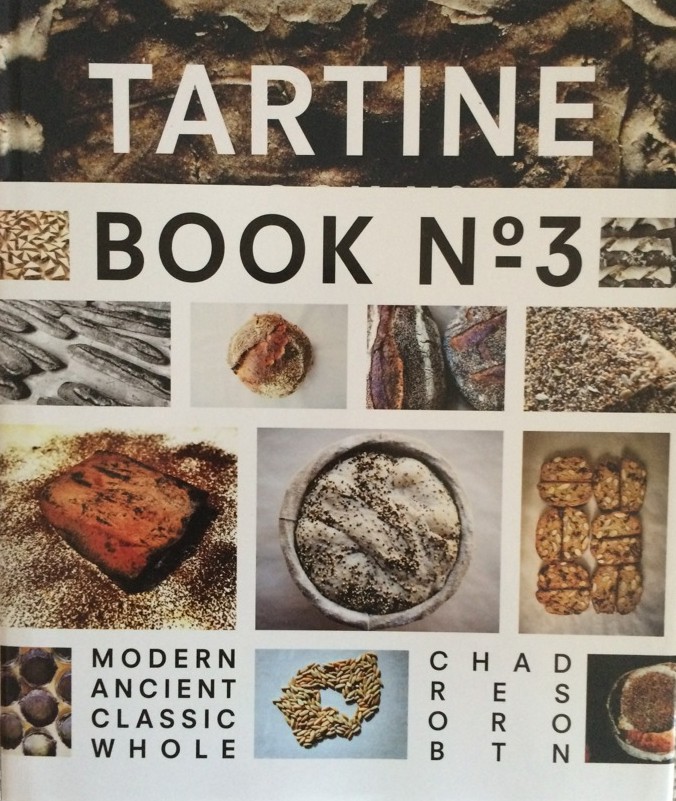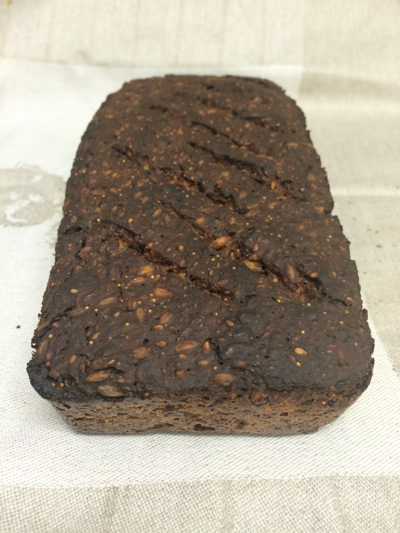Tartine Book No3: the art of slow bread and pastry
Tartine Bakery in San Francisco’s hip Mission district, where the current “foodfarians” cook almost anything from scratch, was one of the initiators of truly artisanal movement in the Bay area. No fancy dining rooms, rather industrial, casual and raw design catering to the millennials’ naturalistic style. A suburb workshop meets the office workforce. For over a decade the evolutionary, rather than revolutionary bakery has been occupied daily by patient bread and pastry lovers waiting for their turn to sniff over their favorite slice with a cup of coffee on the side. Its success called for sharing more, as many of its fans longed for the secrets of their oven to be revealed to them so they can perhaps replicate it at home. The James Beard Foundation awardees for ‘Oustanding Pastry Chef’ followed up with beautiful series of detailed instruction.

The Third Tartine Book by its co-founding baker Chad Robertson reflects old-wisdom freshened up by modern experimentation techniques. Baking grounded in “Modern, Ancient, Classic and Whole” catchphrases. ‘Modern’ global inspiration is applied to ‘Ancient’ ‘Whole’ grains as they are rediscovered and wild fermentation is used to the maximum for easier digestibility. ‘Classic’ French baking techniques like Poilane’s naturally leavened pain au levain are also utilized by this internationally recognized artisan baker together with his learnt accent (from his Richard Bourdon) on better enzymatic work and development of lactic acid through an increased hydration of the leaven and the dough, again making the baked bread more digestible.


Baking your own bread became unnecessary once the food industry figured out how to speed the process up, but rushing the bread was on the account of easier digestibility and quality. Baking from the Tartine Book No3 is weeks-lasting kitchen project. Like its sister restaurant’s Bar Tartine cookbook, each technical detail is dissected, pictured step by step, all with the master methods for each type of the baked specialties. You will learn how to master basic bread loafs, seeded, sprouted, porridge and fermented breads, crispbreads as well as pastries inspired by international baking traditions.

History of baking with a spotlight on Denmark, Sweden, Germany & Austria, France and Mexico, will grab your attention through alluring anecdotes. The European tradition and its influence on the postmodern American artisanal baking is a particularly interesting read. Inserted between each chapter is a country-specific essay highlighting its baking influencers, trends and popular baked goods. This is not a bible of baking, but rather Tartine’s adaptation of various baking traditions for their natural baking business in San Francisco. The author, Robertson, knows his ouevre and applies strict rules to the quality of his building material as well as the process of making the bread itself. He sums up his team’s approach: “The doughs must be made with the best quality organic, biodynamic, freshly milled grains with ample hydration, slow and gentle mixing, and long rising time using a natural leaven.”
My attempts to baking from this book proved that for the breads you better re-read the intiating “Whole Grain Primer” and “Mastering Method for Tartine Loaves” chapters. Otherwise, you will keep frantically flipping the pages, while spilling from a cup of water in your hand, flour in another, and over all that wonder how to incorporate the leaven correctly. Chaos!


The most time-consuming is the leaven (also known as desem, starter). Once you train it (about 10-15 days) so the dough doubles within a day just with a small amount of the souring blend of water and flour (=leaven), you are set for baking forever. Unless, you travel frequently for longer than a period of one week, then you will have to repeat the entire process of training the starter again. This shows how much under-appreciated a real, high quality bread is today!
After mastering the leaven, my first project was the popular René’s Rye bread sold at the Tartine Bakery. Named after a Danish chef René Bolvig, who gave the base recipe to Robertson, its evolved version resembles its original only in terms of rye and sprouting. The baker notes that “Sprouting the grain makes the bead more digestible, and adds natural sweetness“. At Tartine, the made-from scratch approach would call for making your own buttermilk, but you can buy it, ideally at an organic store for perfect results. After an upper body workout of kneeding the dough, flipping the pages as the instructions guided, leaving memorable imprints of sticky dough on the paper, I formed a nice seedy loaf. Achieving the perfect consistency of sticky but spotless dough in the bowl, in a childlike playfulness, I was experimenting with shapes (look bellow for inspiration).


When baking from this book, take your time, after all the slow bread movement got its name for a reason. For good results additionally, using spring, top quality water instead of tap water is preferable. You probably will not have a wood-fired oven at home, but an electric or gas oven will do the job just fine. Wood would impart better flavors into the bread and in sync with the macrobiotic lifestyle it would “remove the oxidizing gases thought to diminish nutrients in the bread“.
After hours of waiting for rising of the dough and over an hour in the oven, the dough turned into a hard crust dark brick-shaped bread, looking almost like the sample I tried at the bakery in San Francisco. As anyone who bakes his/her own bread would endorse, I was proud! But, wait, the baker advises: “I wait until the next day to cut into the beard, as the crumb is very moist and the resting times make it easier to slice this bread thinly”. A real test of patience.
The positive note is that the bead keeps for up to one week, and any leftovers turn into perfect cheese crackers if you slice it thin and dehydrate it on a low temperature.


Making Crispbreads proved more challenging than any bread I have attempted so far. It is necessary to lower the hydration of the typical Tartine bread dough, so it does not stick to the rolling pin. The thin rolling of each individual piece nears the effort to pastry making making for an ideal next step before attempting the recipes in the final ‘Pastry’ chapter of the book. Like in pottery, shaping the matter (dough) and crafting each edge into a symmetrical object or curving it wildly so it looks as if intended, requires know-how. With experience or luck your crispbreads will look better than store-bought. Even if their form gets quirky, their fresh taste is incomparable to the plastic-wrapped processed crackers on the shelves of most supermarkets.

Like Chad, I like to experiment with toppings – blending various raw seeds, nuts and even dried herbs and flowers for Michelin-looking creations. I made three recipes; René-Style Crispbreads, Buckwheat-Nori Crispbreads and the Wheat-Rye Crispbreads with Caraway. All turned wonderful, but I wish I had a good pasta rolling machine to run them through instead of crafting them, sweating, under the rolling pin. So much work deterred me from attempting the more advanced flowery canvases similar to those I saw at the three-Michelin starred Luis XV. restaurant by Allain Ducasse. I’m not a kitchen artist, yet!




The final ‘Pastry’ part includes some classic recipes such as the french Brioche, Croquant d’Amandes cookies, sublime ultra Chocolate cake spiked with rhubarb jam and crafty Éclairs. Fill in some American favorites (Pecan Shortbread, Peanut Butter Cookies,…). Perfect weekend tea cakes (exquisite Zucchini Kumquat Tea Cake, Fruit Scones,…). Perfectly matching any aperitif were savory bites (Cheddar or Blue Cheese Sables as well as the Cheese gougers). Exotic spices and herbs (I loved the dried Chamomile Kamut Shortbread I took on the flight to the Bermudas).

The plum jam in the Bohemian Apple Layer Cake reminded me of my native Moravia in Czechia. Here, typically autumnal ingredients like apples, prunes and raisins call for their use in the kitchen. The cake turned much richer than my country’s “kolace”. Layering is always a challenge, and unmolding it onto a wire rack was not that straightforward as was described in the recipe. I would welcome a trick on how to do it without breaking the sponge layer. Being resourceful is one of the most important traits in the kitchen, and luckily I am quite good at it, so like a construction engineer, I supported the sponge with a long metal cake server on its longer side and a wide knife on the other, then carefully moved it. Now just spread the apple and prune compotes in the mid layer and put it back up. The cake was exquisite with a cup of more oxidized oolong tea, but what we kept spooning from our fridge for the coming days was the leftover prune compote. Perhaps the addition of a brandy made it so addictive!


Since the real traditional baking is about flour and most even about grains, it is essential, as Robertson to his credit conveys through his book, to know the differences between each type of grain, what flavor they impart, how much binding gluten they contain, if sprouting unlocks some of their benefits for the final baked product and particularly in pastry how finely milled it has to be. This book answers most of the relevant grainy questions, so you slowly become to understand why you are doing something when baking, which makes the process much more meaningful, than just lab-like measuring and weighing of the ingredients, that often takes away most of the joy from baking. Some points remained unclear to me after baking from this book, however. Such as Robertson’s term “bread flour” or “medium-strong bread flour“. Is it his 50/50 mix of white and whole-wheat flour as in the making of the starter? His description on page 24 of a flour with 11-12 percent gluten does not make it easy to grasp for a typical home baker. There may rise many “???” in your mind, you even might be talking loudly in the kitchen to yourself “What does he mean by…?“. Yet, baking is a craft and you need to get your hands dirty first, fight yourself through average results until you find your way – with the help of this book, but not entirely dependent on it, to a perfect loaf of bread.

The pictures look spotless. Don’t be discouraged if your first loaf or crisp bread is not Instagram perfect, since baking is for everyone a long journey to consistent perfection. The more you bake, the better the result. By no means the Tartine Book supplies you with easy-to-make recipes, but you will be set to become a home master baker wowing the entire family with what comes from the oven. To ramp up your motivation, the aroma of almost baked bread, cake or any pastry that escapes from the oven is the most comforting home perfume you can imagine. So, heat it up!

If you travel to San Francisco then join the long daily line by the Bakery. These people know how much work they had saved for themselves! Comforted and smiling over cup of cappucino with a piece of gougere, a chocolate brownie, a cookie and a with my fingers pinching in the René’s Rye bread, I savored them all at once, aware of the days involved in baking these irresistible morsels of baked milled grains. All organic, of course.

